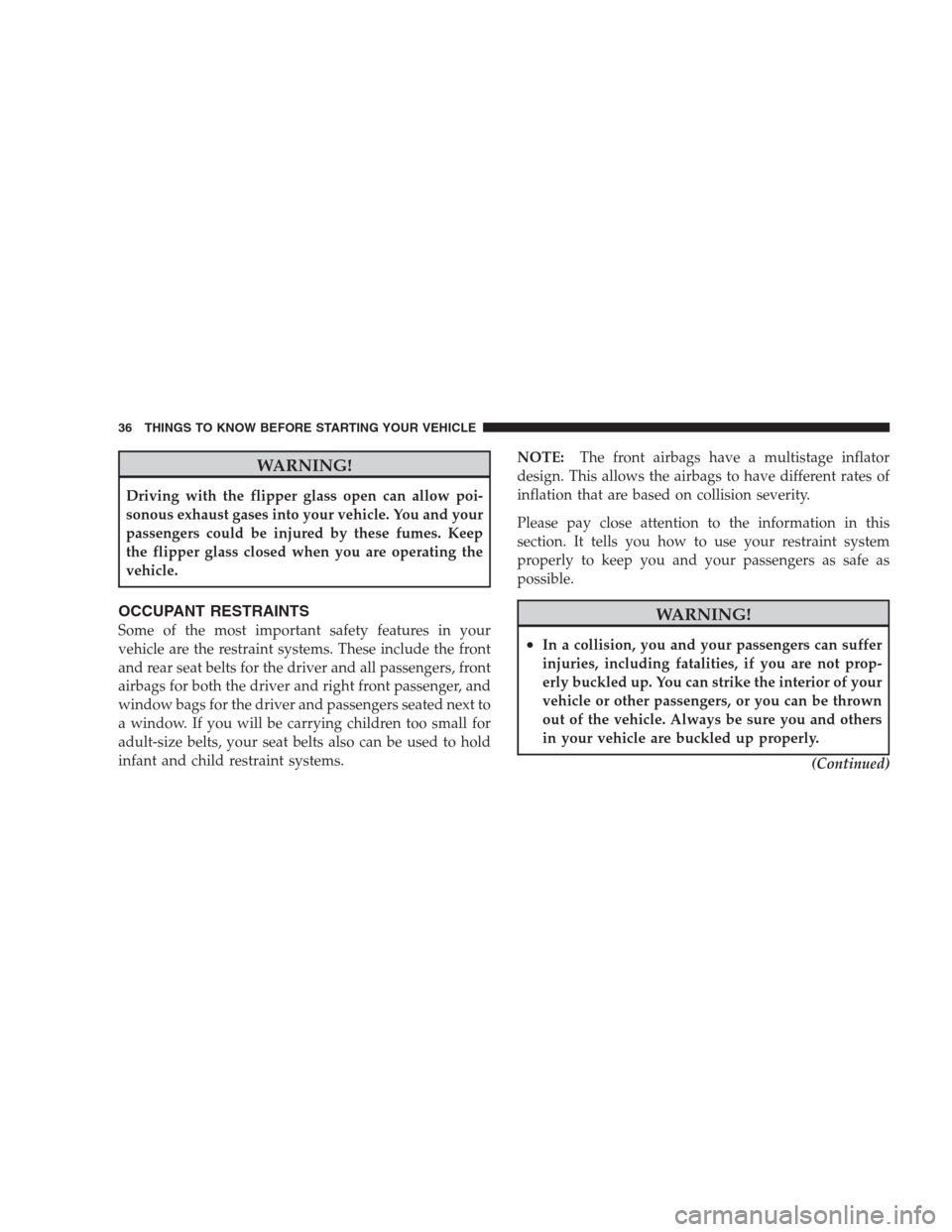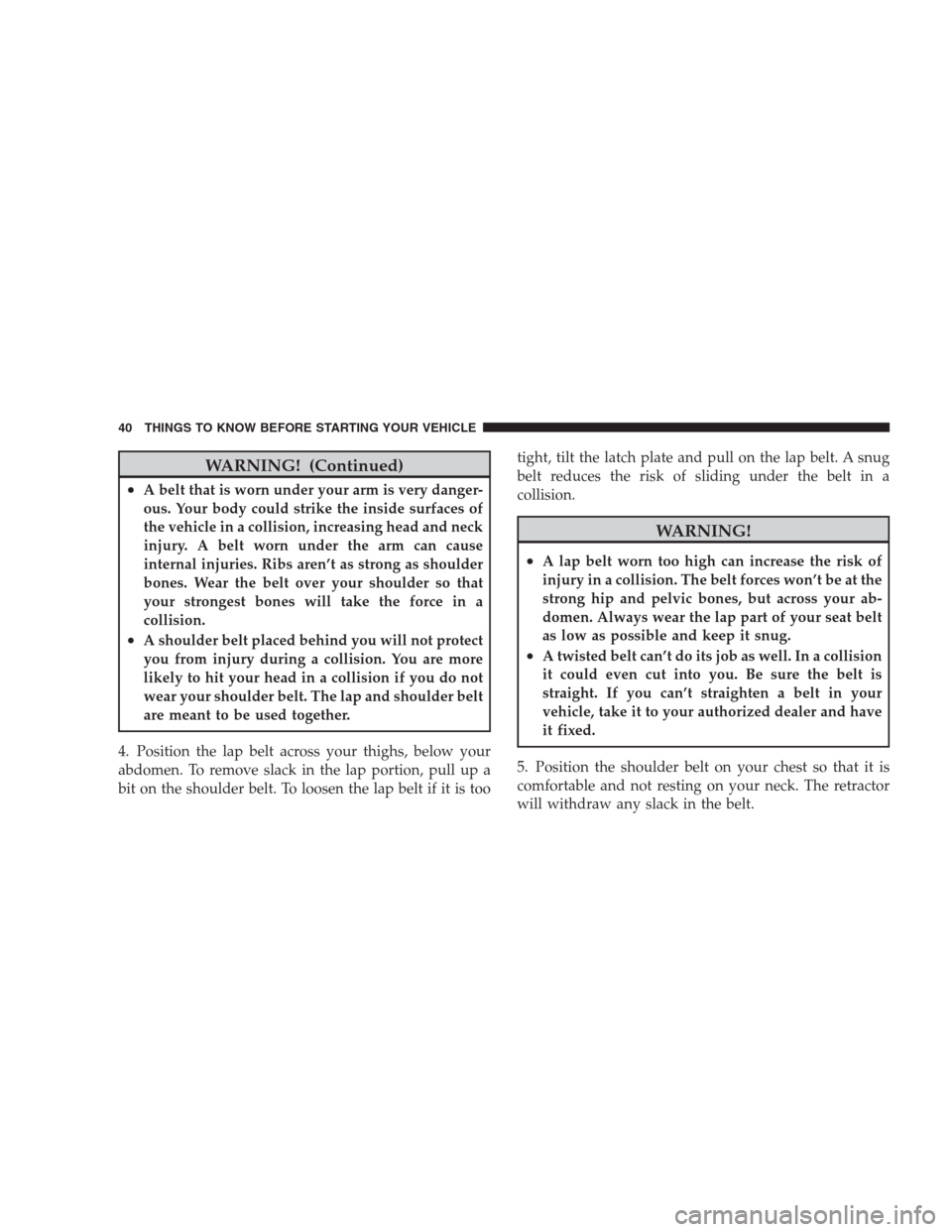Page 8 of 521
Failure to use driver and passenger seat beltsprovided
is a major cause of severe or fatal injury. In fact, the U.S.
government notes that the universal use of existing seat
belts could cut the highway death toll by 10,000 or more
each year and could reduce disabling injuries by two
million annually. In a rollover crash, an unbelted person
is significantly more likely to die than a person wearing
a seat belt. Always buckle up.HOW TO USE THIS MANUAL
Consult the Table of Contents to determine which section
contains the information you desire.
The detailed index at the back of this Owner’s Manual
contains a complete listing of all subjects.
Consult the following table for a description of the
symbols that may be used on your vehicle or throughout
this Owner’s Manual:
6 INTRODUCTION
Page 14 of 521

▫Express Down Window Feature — If
Equipped........................... 24
▫Using The Panic Alarm................. 25
▫Programming Additional Transmitters...... 25
▫Transmitter Battery Service.............. 25
▫General Information................... 26
�Remote Starting System — If Equipped....... 27
▫How To Use Remote Start............... 27
�Door Locks........................... 29
▫Manual Door Locks................... 29
▫Power Door Locks.................... 29
▫Child Protection Door Lock.............. 30
�Windows............................ 31▫Power Windows...................... 31
▫Wind Buffeting....................... 33
�Liftgate............................. 34
▫Liftgate Flipper Glass.................. 35
�Occupant Restraints..................... 36
▫Lap/Shoulder Belts.................... 37
▫Lap/Shoulder Belt Operating Instructions.... 38
▫Adjustable Upper Shoulder Belt Anchorage . . . 41
▫Automatic Locking Mode — If Equipped.... 42
▫Energy Management Feature............. 43
▫Seat Belt Pretensioners................. 43
▫Enhanced Seat Belt Use Reminder System
(BeltAlert�) ......................... 44
12 THINGS TO KNOW BEFORE STARTING YOUR VEHICLE
Page 15 of 521
▫Seat Belts And Pregnant Women.......... 45
▫Seat Belt Extender..................... 45
▫Driver And Front Passenger Supplemental
Restraint Systems (SRS)................. 46
▫Child Restraints...................... 58
�Engine Break-In Recommendations.......... 68
�Safety Tips........................... 69▫Transporting Passengers................ 69
▫Exhaust Gas......................... 69
▫Safety Checks You Should Make Inside The
Vehicle............................. 70
▫Periodic Safety Checks You Should Make
Outside The Vehicle................... 71
THINGS TO KNOW BEFORE STARTING YOUR VEHICLE 13
2
Page 38 of 521

WARNING!
Driving with the flipper glass open can allow poi-
sonous exhaust gases into your vehicle. You and your
passengers could be injured by these fumes. Keep
the flipper glass closed when you are operating the
vehicle.
OCCUPANT RESTRAINTS
Some of the most important safety features in your
vehicle are the restraint systems. These include the front
and rear seat belts for the driver and all passengers, front
airbags for both the driver and right front passenger, and
window bags for the driver and passengers seated next to
a window. If you will be carrying children too small for
adult-size belts, your seat belts also can be used to hold
infant and child restraint systems.NOTE:The front airbags have a multistage inflator
design. This allows the airbags to have different rates of
inflation that are based on collision severity.
Please pay close attention to the information in this
section. It tells you how to use your restraint system
properly to keep you and your passengers as safe as
possible.WARNING!
•In a collision, you and your passengers can suffer
injuries, including fatalities, if you are not prop-
erly buckled up. You can strike the interior of your
vehicle or other passengers, or you can be thrown
out of the vehicle. Always be sure you and others
in your vehicle are buckled up properly.
(Continued)
36 THINGS TO KNOW BEFORE STARTING YOUR VEHICLE
Page 39 of 521

WARNING! (Continued)
•Buckle up even though you are an excellent driver,
even on short trips. Someone on the road may be a
poor driver and cause a collision which includes
you. This can happen far away from home or on
your own street.
•Research has shown that seat belts save lives, and
they can reduce the seriousness of injuries in a
collision. Some of the worst injuries happen when
people are thrown from the vehicle. Seat belts
reduce the possibility of ejection and the risk of
injury caused by striking the inside of the vehicle.
Everyone in a motor vehicle should be belted at all
times to reduce or prevent injuries.
Lap/Shoulder Belts
All seating positions in your vehicle have combination
lap/shoulder belts. The belt webbing retractor is de-
signed to lock during very sudden stops or collisions.This feature allows the shoulder part of the belt to move
freely with you under normal conditions. But in a colli-
sion, the belt will lock and reduce the risk of you striking
the inside of the vehicle or being thrown out.
WARNING!
•Wearing a seat belt incorrectly is dangerous. Seat
belts are designed to go around the large bones of
your body. These are the strongest parts of your
body and can take the forces of a collision the best.
Wearing your belt in the wrong place could make
your injuries in a collision much worse. You might
suffer internal injuries, or you could even slide out
of part of the belt. Follow these instructions to
wear your seat belt safely and to keep your pas-
sengers safe, too.
(Continued)
THINGS TO KNOW BEFORE STARTING YOUR VEHICLE 37
2
Page 40 of 521
WARNING! (Continued)
•Two people should never be belted into a single
seat belt. People belted together can crash into one
another in an accident, hurting one another badly.
Never use a lap/shoulder belt or a lap belt for more
than one person, no matter what their size.
Lap/Shoulder Belt Operating Instructions
1. Enter the vehicle and close the door. Sit back and
adjust the seat.
2. The seat belt latch plate is above the back of your seat.
Grasp the latch plate and pull out the belt. Slide the latch
plate up the webbing as far as necessary to make the belt
go around your lap.3. When the belt is long enough to fit, insert the latch
plate into the buckle until you hear a “click.”
Latch Plate
38 THINGS TO KNOW BEFORE STARTING YOUR VEHICLE
Page 41 of 521
WARNING!
•A belt that is buckled into the wrong buckle will
not protect you properly. The lap portion could
ride too high on your body, possibly causing
internal injuries. Always buckle your belt into the
buckle nearest you.
•A belt that is too loose will not protect you as well.
In a sudden stop you could move too far forward,
increasing the possibility of injury. Wear your seat
belt snugly.
(Continued)
Latch Plate to Buckle
THINGS TO KNOW BEFORE STARTING YOUR VEHICLE 39
2
Page 42 of 521

WARNING! (Continued)
•A belt that is worn under your arm is very danger-
ous. Your body could strike the inside surfaces of
the vehicle in a collision, increasing head and neck
injury. A belt worn under the arm can cause
internal injuries. Ribs aren’t as strong as shoulder
bones. Wear the belt over your shoulder so that
your strongest bones will take the force in a
collision.
•A shoulder belt placed behind you will not protect
you from injury during a collision. You are more
likely to hit your head in a collision if you do not
wear your shoulder belt. The lap and shoulder belt
are meant to be used together.
4. Position the lap belt across your thighs, below your
abdomen. To remove slack in the lap portion, pull up a
bit on the shoulder belt. To loosen the lap belt if it is tootight, tilt the latch plate and pull on the lap belt. A snug
belt reduces the risk of sliding under the belt in a
collision.
WARNING!
•A lap belt worn too high can increase the risk of
injury in a collision. The belt forces won’t be at the
strong hip and pelvic bones, but across your ab-
domen. Always wear the lap part of your seat belt
as low as possible and keep it snug.
•A twisted belt can’t do its job as well. In a collision
it could even cut into you. Be sure the belt is
straight. If you can’t straighten a belt in your
vehicle, take it to your authorized dealer and have
it fixed.
5. Position the shoulder belt on your chest so that it is
comfortable and not resting on your neck. The retractor
will withdraw any slack in the belt.
40 THINGS TO KNOW BEFORE STARTING YOUR VEHICLE